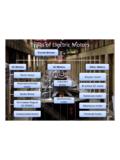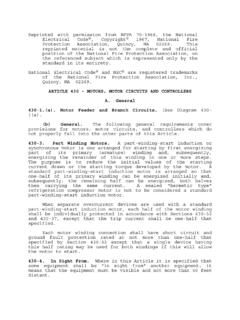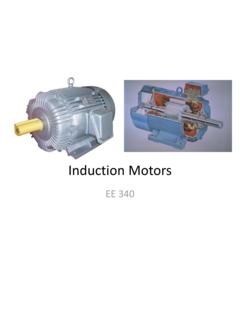Transcription of Chapter 2 Actuators and Drive Systems - MIT OpenCourseWare
1 Introduction to Robotics, H. Harry Asada 1 Chapter 2 Actuators and Drive Systems Actuators are one of the key components contained in a robotic system. A robot has many degrees of freedom, each of which is a servoed joint generating desired motion. We begin with basic actuator characteristics and Drive amplifiers to understand behavior of servoed joints. Most of today s robotic Systems are powered by electric servomotors. Therefore, we focus on electromechanical Actuators . DC Motors Figure 2-1 illustrates the construction of a DC servomotor, consisting of a stator, a rotor, and a commutation mechanism. The stator consists of permanent magnets, creating a magnetic field in the air gap between the rotor and the stator. The rotor has several windings arranged symmetrically around the motor shaft.
2 An electric current applied to the motor is delivered to individual windings through the brush-commutation mechanism, as shown in the figure. As the rotor rotates the polarity of the current flowing to the individual windings is altered. This allows the rotor to rotate continually. Figure Construction of DC motor Let m be the torque created at the air gap, and i the current flowing to the rotor windings. The torque is in general proportional to the current, and is given by iKtm = ( ) where the proportionality constant is called the torque constant, one of the key parameters describing the characteristics of a DC motor. The torque constant is determined by the strength of the magnetic field, the number of turns of the windings, the effective area of the air gap, the radius of the rotor, and other parameters associated with materials properties.
3 TKIn an attempt to derive other characteristics of a DC motor, let us first consider an idealized energy transducer having no power loss in converting electric power into mechanical Department of Mechanical Engineering Massachusetts Institute of Technology Angle qStator WindingBearingsShaftBrushRotor WindingsiaNCommutatorSInertia LoadFigure by MIT to Robotics, H. Harry Asada 2power. Let E be the voltage applied to the idealized transducer. The electric power is then given by , which must be equivalent to the mechanical power: iE mminiEP = = ( ) where m is the angular velocity of the motor rotor. Substituting eq.(1) into eq.(2) and dividing both sides by i yield the second fundamental relationship of a DC motor: mtKE = ( ) The above expression dictates that the voltage across the idealized power transducer is proportional to the angular velocity and that the proportionality constant is the same as the torque constant given by eq.
4 (1). This voltage E is called the back emf (electro-motive force) generated at the air gap, and the proportionality constant is often called the back emf constant. Note that, based on eq.(1), the unit of the torque constant is Nm/A in the metric system, whereas the one of the back emf constant is V/rad/s based on eq.(2). Exercise Show that the two units, Nm/A and V/rad/s, are identical. The actual DC motor is not a loss-less transducer, having resistance at the rotor windings and the commutation mechanism. Furthermore, windings may exhibit some inductance, which stores energy. Figure shows the schematic of the electric circuit, including the windings resistance R and inductance L. From the figure, EdtdiLiRu++ = ( ) where u is the voltage applied to the armature of the motor.
5 L R u i E m m Figure Electric circuit of armature Combining eqs.(1), (3) and (4), we can obtain the actual relationship among the applied voltage u, the rotor angular velocity m , and the motor torque m . mtmemtRKdtdTuRK 2++= ( ) Department of Mechanical Engineering Massachusetts Institute of Technology Introduction to Robotics, H. Harry Asada ent of Mechanical Engineering Massachusetts Institute of Technology 3where time constant RLTe=, called the motor reactance, is often negligibly small. Neglecting this second term, the above equation reduces to an algebraic relationship: mttmRKuRK 2 = ( ) This is called the torque-speed characteristic. Note that the motor torque increases in proportion to the applied voltage, but the net torque reduces as the angular velocity increases.
6 Figure illustrates the torque-speed characteristics. The negative slope of the straight lines,RKt2 , implies that the voltage-controlled DC motor has an inherent damping in its mechanical behavior. The power dissipated in the DC motor is given by 222mtdisKRiRP = = ( ) from eq.(1). Taking the square root of both sides yields ,mdismmtKPKKR == ( ) where the parameter is called the motor constant. The motor constant represents how effectively electric power is converted to torque. The larger the motor constant becomes, the larger the output torque is generated with less power dissipation. A DC motor with more powerful magnets, thicker winding wires, and a larger rotor diameter has a larger motor constant. A motor with a larger motor constant, however, has a larger damping, as the negative slope of the torque-speed characteristics becomes steeper, as illustrated in Figure mK m -Km2 Pout m maxm max21u m max m Figure Torque-speed characteristics and output power DepartmIntroduction to Robotics, H.
7 Harry Asada 4 Taking into account the internal power dissipation, the net output power of the DC motor is given by mmmtmmoutKuRKP )(2 = = ( ) This net output power is a parabolic function of the angular velocity, as illustrated in Figure It should be noted that the net output power becomes maximum in the middle point of the velocity axis, 50 % of the maximum angular velocity for a given armature voltage u. This implies that the motor is operated most effectively at 50 % of the maximum speed. As the speed departs from this middle point, the net output power decreases, and it vanishes at the zero speed as well as at the maximum speed. Therefore, it is important to select the motor and gearing combination so that the maximum of power transfer be achieved. Dynamics of Single-Axis Drive Systems DC motors and other types of Actuators are used to Drive individual axes of a robotic system.
8 Figure shows a schematic diagram of a single-axis Drive system consisting of a DC motor, a gear head, and arm links1. An electric motor, such as a DC motor, produces a relatively small torque and rotates at a high speed, whereas a robotic joint axis in general rotates slowly, and needs a high torque to bear the load. In other words, the impedance of the actuator: mmmvelocityangulartorqueZ == ( ) is much smaller than that of the load. load load Joint Axis Gearing Arm Links DC Motor Figure Joint axis Drive system 1 Although a robotic system has multiple axes driven by multiple Actuators having dynamic interactions, we consider behavior of an independent single axis in this section, assuming that all the other axes are fixed.
9 Department of Mechanical Engineering Massachusetts Institute of Technology Introduction to Robotics, H. Harry Asada 5To fill the gap we need a gear reducer, as shown in Figure Let 1>rbe a gear reduction ratio (If d1 and d2 are diameters of the two gears, the gear reduction ratio is ). The torque and angular velocity are changed to: 12/ddr= mloadmloadrr 1,= = ( ) where load and load are the torque and angular velocity at the joint axis, as shown in the figure. Note that the gear reducer of gear ratio r increases the impedance r2 times larger than that of the motor axis Zm: mloadZrZ =2 ( ) Let Im be the inertia of the motor rotor. From the free body diagram of the motor rotor, loadmmmrI 1 = ( ) where loadr 1 is the torque acting on the motor shaft from the joint axis through the gears, and m is the time rate of change of angular velocity, the angular acceleration.
10 Let be the inertia of the arm link about the joint axis, and b the damping coefficient of the bearings supporting the joint axis. Considering the free body diagram of the arm link and joint axis yields lI loadloadloadlbI = ( ) Eliminating load from the above two equations and using eq.( ) and ( ) yields ukBIloadload =+ ( ) where I, B, k are the effective inertia, damping, and input gain reflected to the joint axis: mlIrII2+= ( ) 22mKrbB+= ( ) RKrkt= ( ) Note that the effective inertia of the motor rotor is r2 times larger than the original value when reflected to the joint axis. Likewise, the motor constant becomes r2 times larger when reflected to the joint axis. The gear ratio of a robotic system is typically 20 ~ 100, which means that the effective inertia and damping becomes 400 ~ 10,000 times larger than those of the motor itself.















